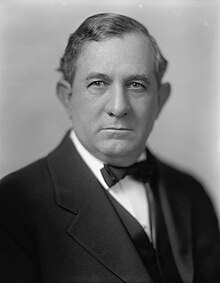Tom Connally | |
|---|---|
 | |
| United States Senator from Texas | |
| In office March 4, 1929 – January 3, 1953 | |
| Preceded by | Earle B. Mayfield |
| Succeeded by | Price Daniel |
| Member of the U.S. House of Representatives from Texas's 11th district | |
| In office March 4, 1917 – March 3, 1929 | |
| Preceded by | Robert L. Henry |
| Succeeded by | Oliver H. Cross |
| Member of the Texas House of Representatives | |
| In office January 8, 1901 – January 10, 1905 | |
| Preceded by | Sam Little |
| Succeeded by | Austin Milton Kennedy W. C. O'Bryan |
| Constituency | 72nd district (1901–1903) 69th district (1903–1905) |
| Personal details | |
| Born | Thomas Terry Connally August 19, 1877 Hewitt, Texas, U.S. |
| Died | October 28, 1963 (aged 86) Washington, D.C., U.S. |
| Political party | Democratic |
| Spouses | Louise Clarkson
(m. 1904; died 1935)Lucile Sanderson Sheppard
(m. 1942) |
| Children | Ben Clarkson Connally |
| Alma mater | Baylor University (AB) University of Texas at Austin (LLB) |
Thomas Terry Connally (August 19, 1877 – October 28, 1963) was an American politician, who represented Texas in both the U.S. Senate and the House of Representatives, as a member of the Democratic Party. He served in the U.S. House of Representatives from 1917 to 1929, and in the U.S. Senate from 1929 to 1953.
He was a segregationist who advocated in favor of Jim Crow laws, for example opposing equal education for black people, and against anti-lynching legislation. In the House, Connally was a staunch Wilsonian Democrat who campaigned in favor of the League of Nations, and the World Court. In the Senate, he chaired the Committee on Foreign Relations from 1941, giving strong support to President Franklin Roosevelt's anti-German and anti-Japanese policies. He worked with Republican Senator Arthur H. Vandenberg to ensure bipartisan support for an internationalist policy, including the new United Nations. He led the committee in supporting the Truman Doctrine in 1947, the Marshall Plan in 1948 and NATO in 1949.[1]
- ^ Bruce W. Jentleson and Thomas G. Paterson, eds. Encyclopedia of US foreign relations. (1997) 1:328.